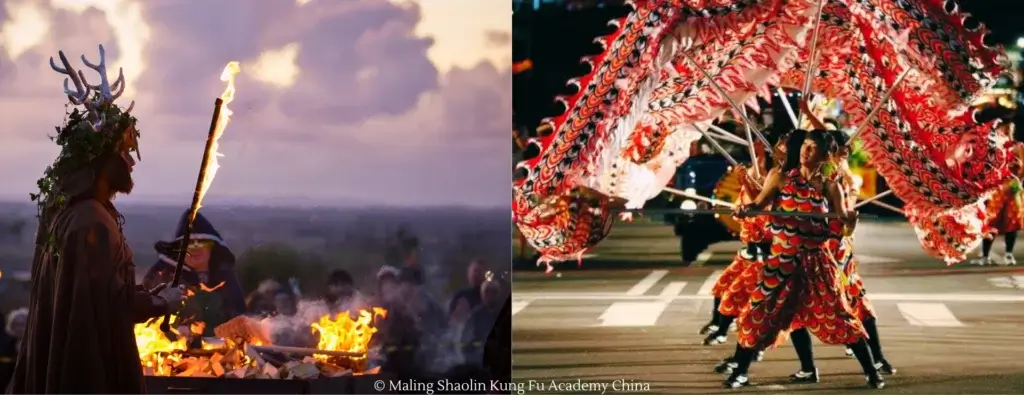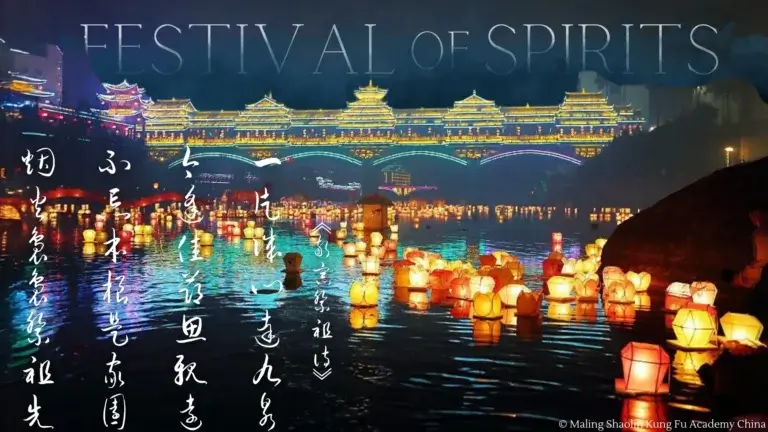
As the air cools and the days shorten, the world celebrates festivals dedicated to spirits, ancestors, and the supernatural. For many in the West, this means Halloween—a spooky time of costumes, trick-or-treating, and eerie decorations. Meanwhile, in China, the Hungry Ghost Festival (中元节, Zhōngyuán Jié) serves a similar purpose, honoring the spirits of the dead. While these festivals may seem alike at first glance, they have distinct origins, rituals, and cultural significance. This article explores the deep historical roots of Halloween, focusing on its Celtic origins, as well as its connection to other ancient observances, and compares them with the Hungry Ghost Festival.
1. Origins and Cultural Background

Halloween:
Halloween’s origins trace back to Samhain, an ancient Celtic festival marking the end of the harvest and the beginning of winter. Held around October 31st to November 1st, Samhain was believed to be a time when the boundary between the living and the dead was thinnest. The Celts believed that on this night, spirits of the dead could return to the Earth. To appease these wandering souls and protect themselves from mischievous or malevolent spirits, the Celts would light bonfires and wear costumes to confuse or ward off ghosts.
When the Roman Empire absorbed Celtic territories, Samhain gradually blended with the Roman festivals of Feralia, which honored the dead, and Pomona, the goddess of fruit and trees. Later, in the 8th century, Pope Gregory III moved All Saints’ Day (or All Hallows’ Day) to November 1st, with the night before becoming All Hallows’ Eve, eventually shortened to Halloween. Despite the Christian overlay, many of Samhain’s original themes of honoring the dead and keeping spirits at bay remained in the holiday’s practices.
Halloween as we know it today, with costumes, trick-or-treating, and spooky decorations, is largely a modern, secular celebration. But beneath the fun, it carries the weight of ancient beliefs about the supernatural world and the balance between the living and the dead.
Hungry Ghost Festival:
The Hungry Ghost Festival, celebrated on the 15th day of the 7th lunar month (usually in August or September), stems from Buddhist, Taoist, and Chinese folk traditions. It’s based on the belief that during this time, the gates of hell are opened, and the souls of the dead are allowed to roam the Earth. These spirits, especially those without descendants to honor them, are believed to be hungry and restless. The festival’s rituals—such as food offerings, burning joss paper, and lighting lanterns—are meant to appease these spirits, ensuring they don’t bring misfortune to the living. Unlike Halloween’s focus on entertainment, the Hungry Ghost Festival is a more solemn occasion, deeply rooted in ancestor worship and the fear of bad luck.
2. Honoring the Spirits

Halloween:
In the ancient Celtic tradition of Samhain, the spirits of the dead were both feared and honored. The Celts lit bonfires to guide the spirits and dressed in costumes, often made of animal skins, to ward off malevolent entities. In addition, offerings of food were made to appease spirits and ensure good fortune in the coming year. These traditions evolved into modern Halloween customs, where people dress up as ghosts, witches, and supernatural creatures, often engaging in playful antics. Today, trick-or-treating (originating from the medieval practice of souling, where the poor would offer prayers for the dead in exchange for food) is the most iconic Halloween tradition. While the modern version is lighthearted, it reflects the ancient belief that the dead should be respected and cared for during this time of spiritual vulnerability.
Hungry Ghost Festival:
During the Hungry Ghost Festival, spirits are honored through more formal rituals. People prepare food offerings such as fruit, rice, and meat to present to the wandering ghosts. They burn joss paper—representing material goods like money, clothes, and even homes—to provide for the ghosts in the afterlife. In some places, monks chant sutras to bring peace to restless souls, while others host theatrical performances like traditional Chinese operas or “ghost marriages”, where a spirit without a spouse is symbolically married to ensure peace. These offerings and performances serve as acts of respect, designed to ensure the spirits are nourished and appeased. The festival is about making sure the dead do not return in anger or cause harm to the living.
3. Rituals and Customs

Halloween:
Halloween’s most famous tradition is trick-or-treating, where children dress in costumes and go door-to-door asking for candy. This practice evolved from medieval customs where the poor would go begging for food in exchange for prayers for the souls of the dead. In addition to trick-or-treating, people often decorate their homes with pumpkins, cobwebs, and spooky figures. These symbols, such as the jack-o’-lantern, originally carved from turnips and later pumpkins, were used to ward off spirits. Haunted houses, Halloween parties, and bonfires continue to be popular ways to celebrate. The modern-day focus on fun and spookiness is a far cry from Samhain’s solemnity, but it retains the fundamental element of honoring the spirits.
Hungry Ghost Festival:
During the Hungry Ghost Festival, food offerings and the burning of joss paper are central rituals. Families gather to honor their ancestors, ensuring they have what they need in the afterlife. In some communities, large lanterns are floated down rivers to guide spirits back to the underworld. Many places also hold performances, including Chinese opera or traditional theater, as it is believed that the spirits enjoy watching entertainment. These performances often take place on makeshift stages set up in the streets, with a focus on appeasing the ghosts while offering entertainment for the living. The festival emphasizes a respectful connection with the spirit world and aims to prevent bad luck or misfortune from haunting the community.
4. The Role of the Supernatural

Halloween:
Historically, Halloween was more about honoring spirits and keeping them at bay, especially during Samhain. The supernatural was both feared and revered, with spirits of the dead believed to return to the Earth. Today, the supernatural aspect of Halloween has largely become playful, with ghosts, goblins, and witches serving as figures of fun rather than actual threats. However, the imagery of death and the unknown still runs through the holiday, often explored through horror films, spooky decorations, and costume choices. Halloween allows us to confront the supernatural in a safe, controlled environment, where fear is part of the thrill.
Hungry Ghost Festival:
The supernatural in the Hungry Ghost Festival is a more tangible presence—the wandering souls are real, and their needs must be tended to. The rituals are designed to placate these souls and ensure they do not cause harm to the living. Unlike Halloween’s playful take on the supernatural, the Hungry Ghost Festival carries a serious reverence for the spiritual realm. The festival reminds people that death is an inevitable part of life and that the spirits of the dead can still influence the living if not properly honored.
5. Influence of Religion

Halloween:
Halloween has roots in pagan traditions and Celtic beliefs, but over time it absorbed Christian elements. All Saints’ Day (November 1st) and All Souls’ Day (November 2nd) were incorporated to honor saints and the souls of the deceased. These Christian influences merged with ancient customs, creating the Halloween celebration we know today. While modern Halloween is largely secular and commercial, some elements of spiritual reflection still exist, particularly the underlying theme of remembering the dead.
Hungry Ghost Festival:
The Hungry Ghost Festival is deeply rooted in Buddhist and Taoist religious practices. The belief that the gates of hell open during the 7th lunar month, allowing souls to roam, is a core tenet of the festival. Taoist priests or Buddhist monks are often invited to chant scriptures and perform rituals to ease the suffering of these wandering spirits. The Buddhist belief in the cycle of life, death, and reincarnation underpins the festival, as people seek to ensure their deceased relatives are peacefully reincarnated. The festival highlights the spiritual connection between the living and the dead, and the importance of maintaining balance between both realms.
6. Community and Family Connections

Halloween:
Halloween has evolved into a community celebration, with neighborhoods coming together for trick-or-treating, parades, and parties. Families dress up, decorate their homes, and enjoy haunted attractions. The festival is a time to enjoy fun, fear, and creativity, especially for children. Despite its secular nature today, it still revolves around family connections and neighborhood unity.
Hungry Ghost Festival:
Similarly, the Hungry Ghost Festival is a time for families to honor their ancestors and ensure their spirits are well cared for. People gather to offer food, burn incense, and light lanterns in memory of their departed loved ones. The festival is a time to reconnect with family and reflect on the importance of honoring the dead, ensuring that family ties remain strong even beyond death.
Conclusion: Two Celebrations, One Spiritual Connection
While Halloween and the Hungry Ghost Festival may seem different at first glance, both are rooted in the ancient belief that the living and the dead are intertwined. Halloween’s origins in Samhain focused on appeasing and honoring spirits, and while modern celebrations emphasize fun and fright, the connection to the supernatural remains. The Hungry Ghost Festival, on the other hand, continues to be a time of solemn reflection and respect, ensuring the spirits of the dead are well-cared for. Both festivals highlight the human desire to connect with the unknown, offering a chance to honor ancestors, reflect on life and death, and celebrate the eternal bond between the living and the dead.



